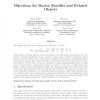Free Online Productivity Tools
i2Speak
i2Symbol
i2OCR
iTex2Img
iWeb2Print
iWeb2Shot
i2Type
iPdf2Split
iPdf2Merge
i2Bopomofo
i2Arabic
i2Style
i2Image
i2PDF
iLatex2Rtf
Sci2ools
99
Voted
JCT
2011
2011
Bijections for Baxter families and related objects
The Baxter number Bn can be written as Bn = n k=0 Θk,n−k−1 with Θk,ℓ = 2 (k + 1)2 (k + 2) k + ℓ k k + ℓ + 1 k k + ℓ + 2 k . These numbers have first appeared in the enumeration of so-called Baxter permutations; Bn is the number of Baxter permutations of size n, and Θk,ℓ is the number of Baxter permutations with k descents and ℓ rises. With a series of bijections we identify several families of combinatorial objects counted by the numbers Θk,ℓ. Apart from Baxter permutations, these include plane bipolar orientations with k + 2 vertices and ℓ + 2 faces, 2-orientations of planar quadrangulations with k + 2 white and ℓ + 2 black vertices, certain pairs of binary trees with k + 1 left and ℓ + 1 right leaves, and a family of triples of non-intersecting lattice paths. This last family allows us to determine the value of Θk,ℓ as an application of the Lemma of Lindstr¨om Gessel-Viennot. The approach also allows us to count certain other subfamilies, e.g., alter...
| Added | 14 May 2011 |
| Updated | 14 May 2011 |
| Type | Journal |
| Year | 2011 |
| Where | JCT |
| Authors | Stefan Felsner, Éric Fusy, Marc Noy, David Orden |
Comments (0)

